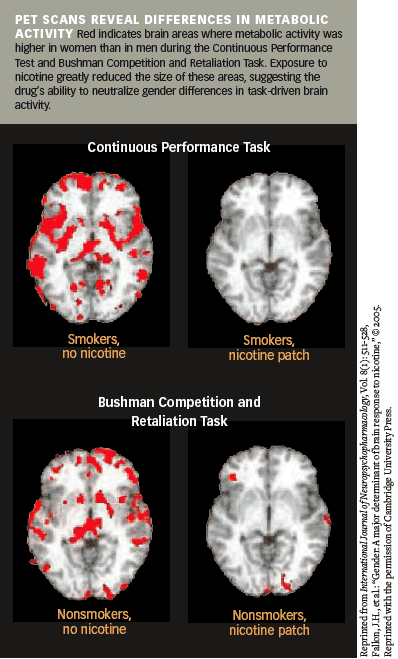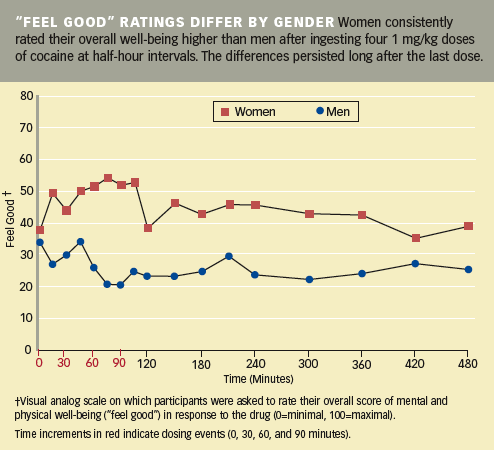Two recent NIDA-funded studies cast new light on men's and women's different responses to nicotine, cocaine, and alcohol. Dr. Steven G. Potkin and colleagues at the University of California (UC), Irvine, demonstrated that various brain regions are more strongly activated in women than in men while they perform certain tasks, and that nicotine equalizes the response. Dr. Elinore F. McCance-Katz and colleagues at the Medical College of Virginia found that women registered greater feelings of physical and mental well-being than men after receiving cocaine and had higher heart rates after drinking alcohol.
Brain Effects of Nicotine
Men and women abuse the same drugs, but not always in the same ways. When women smoke cigarettes, they take shorter and fewer puffs and experience improvements in mood that men do not. Women generally are less successful in quitting. To the UC Irvine study team, these behavioral and experiential differences suggested that nicotine might affect men's and women's brains differently.
Using positron emission tomography (PET), the researchers tracked brain metabolism in 42 women and 77 men (55 smokers and 64 nonsmokers) while they performed two tasks. In the Continuous Performance Task (CPT), a test of vigilance, the study participant watched a series of numbers flashed on a screen and pressed a button when certain figures appeared. The objective of the Bushman Competition and Retaliation Task (BCRT) was to provoke an aggressive response: The participant and an unseen opponent (actually a computer) competed in a test of reaction time, with the loser receiving a blast of noise whose volume and duration were determined by the winner. When the participant lost, which was always the case in early rounds, he or she was shown the noise level that his or her opponent had set; when participants finally won, they could choose how loud and long to blast the opponent back. Participants performed each task once with a placebo patch and once with a transdermal nicotine patch.
When smokers performed the CPT wearing the placebo patch, women's brain metabolism was significantly higher than men's, particularly in the cortical and subcortical prefrontal systems—areas associated with choice, attention, executive function, mood, and memory. These differences largely disappeared when participants wore the nicotine patch: Brain metabolism increased for men and decreased for women. Among nonsmokers, there was little difference in brain activity in men and women while performing the CPT, either with the nicotine patch or with placebo.

With the BCRT, in contrast, it was among nonsmokers that the male-female difference was most marked: Women's brain activity was higher in virtually all regions when the task was performed with placebo, but both sexes exhibited equal activity with nicotine. The gender disparity was smaller among smokers, and this, too, disappeared when they wore the nicotine patch.
"Some effects of nicotine on brain metabolism was not due to the effects of chronic smoking, but rather a fundamental biological difference between men and women in their response to nicotine," Dr. Potkin says. "Everyone knew that there were differences in male and female smoking behavior and smoking rates, but assumed they were just cultural. Based on our findings, a more likely explanation is an interplay of cultural and biological differences. That provides an interesting starting point for devising gender specific interventions."
Effects of Alcohol, Cocaine, and Both Combined
Dr. McCance-Katz's study took as a starting point the observation that people frequently consume alcohol and cocaine simultaneously. "We wanted to understand why that might be and whether responses differed in men and women," says Dr. McCance-Katz.
In the double-blind study, nine men and eight women who were addicted to both cocaine and alcohol participated in three experiments performed on successive days. During the first, they received four 1 mg/kg intranasal doses of cocaine at 30-minute intervals, and two oral doses of alcohol 1 hour apart, in amounts calculated to maintain plasma alcohol concentrations of approximately 100 mg/dL; in the second, cocaine along with alcohol placebo; and in the third, alcohol along with cocaine placebo. The protocol was designed to approximate how cocaine and alcohol might be used together during a day-long binge, Dr. McCance-Katz says. The researchers monitored the participants' psychological and physiological status over an 8-hour period during and after the administration of the drugs.
By most measures, the men's and women's responses did not differ significantly. The researchers did note that women's hearts beat significantly faster than men's when given alcohol alone. Although men and women reported similar ratings of "rush," "any high," "cocaine high," "sad," "depressed," "nervous," or "paranoid" after taking cocaine, women consistently scored higher than men on "feel good"—a rating of combined mental and physical well-being—throughout an observation period starting with their first dose of cocaine and lasting until 6.5 hours after the last. On a scale from 0 to 100, the women's scores ranged from 36 to 54, whereas the men's ranged from a much lower 20 to 34, thus showing no overlap in scores. Gender differences in subjective response to cocaine and alcohol combined, or to alcohol alone, did not attain significance.

"We were a little surprised that women rated their well-being higher [after taking cocaine]," Dr. McCance-Katz says. In previous studies that involved single, somewhat larger doses, women had reported greater anxiety than men when they consumed cocaine. Although it is impossible to predict exactly how feelings of well-being might influence use of the drug, they could well increase the risk of toxicity, says Dr. McCance-Katz. "If you have a strong sense of good mental and physical well-being, you might not be attuned to the internal stimuli that signal the need to stop." Coupled with the fact that cocaine is the illicit drug most often cited by medical examiners in autopsies of female decedents, the finding underlines the importance of bringing more women into treatment and conducting further studies to explore which modalities are effective for women, she says.
Dr. Cora Lee Wetherington, Women and Gender Research Coordinator at NIDA, observes that Dr. McCance-Katz's findings echo animal research showing that female rats exhibit higher levels of motivation for cocaine self-administration than male rats and may be particularly sensitive to the drug's reinforcing effects. "The results of all these studies attest to the importance of not taking a unisex approach to the analysis of data," comments Dr. Wetherington. "Otherwise, you could come up with averaged findings that don't apply to men or women."
Dr. Jamie Biswas, Chief of the Medications Research Grants Branch at NIDA, says that larger studies should explore why substances of abuse appear to elicit a greater perception of well-being among women. Future research might include women in diverse locales and situations and directly address whether they are more easily addicted or harder to treat than men.
Sources
- Fallon, J.H., et al. Gender: A major determinant of brain response to nicotine. International Journal of Neuropsychopharmacology 8(1):17-26, 2005.
- McCance-Katz, E.F., et al. Gender effects following repeated administration of cocaine and alcohol in humans. Substance Use & Misuse 40(4):511-528, 2005. [Abstract]
